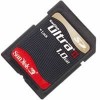SanDisk SDSDH-1024 Product Manual - Page 95
Read CID/CSD Registers, Reset Sequence
 |
UPC - 710348911073
View all SanDisk SDSDH-1024 manuals
Add to My Manuals
Save this manual to your list of manuals |
Page 95 highlights
Revision 2.2 Figure 5-6 No Data Operations From Host to Card DataIn From Card to Host Command DataOut Response Command Chapter 5 - SPI Protocol SD Card Product Manual From Host to Card From Card to Host Response Busy 5.7 Read CID/CSD Registers Unlike the SD bus protocol (where the register contents are sent as a command response), reading the contents of the CSD and CID registers in SPI mode is a simple read-block transaction. The card will respond with a standard response token followed by a data block of 16 bytes suffixed with a 16-bit CRC. The data time out for the CSD command cannot be set to the card TAAC since this value is stored in the CSD. Therefore, the standard response time-out value (NCR) is used for read latency of the CSD Register. 5.8 Reset Sequence The SD Memory Card requires a defined reset sequence. After power on reset or CMD0 (software reset) the card enters an idle state. At this state the only valid host commands are ACMD41 (SD_SEND_OP_COND), CMD58 (READ_OCR) and CMD59 (CRC_ON_OFF). For the Thick (2.1mm) SD Memory Card - CMD1 (SEND_OP_COND) is also valid - that means that in SPI mode CMD1 and ACMD41 have the same behavior, though the usage of CMD41 is preferable because it allows easy distinguishing between SD Memory Card and MultiMediaCard. For the Thin (1.4mm) SD Card CMD1 (SEND_OP_COND) is illegal command during the initialization that is done after power on. After Power On, once the card accepted valid ACMD41, it will be able to accept also CMD1 even if used after re-initializing (CMD0) the card. It was defined in such way in order to be able to distinguish between Thin SD Memory Card and MultiMediaCards (that supports CMD1 as well). The host must poll the card (by repeatedly sending CMD1 or ACMD41) until the 'in-idlestate' bit in the card response indicates (by being set to 0) that the card completed its initialization processes and is ready for the next command. In SPI mode, as opposed to SD mode, ACMD41 (or CMD1 as well, for 2.1mm-SD Card) has no operands and does not return the contents of the OCR register. Instead, the host may use CMD58 (available in SPI mode only) to read the OCR register. Furthermore, it is in the responsibility of the host to refrain from accessing cards that do not support its voltage range. The usage of CMD58 is not restricted to the initializing phase only, but can be issued at any time. © 2004 SanDisk Corporation 5-5 12/08/04















